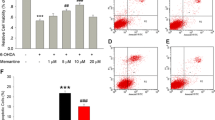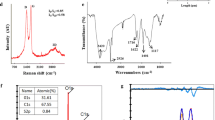Abstract
Glial cell line-derived neurotrophic factor (GDNF) is a potent neurotrophic factor for substantia nigra dopaminergic (DA) neuronal cells. Recent studies have demonstrated that neural cell adhesion molecule functions as a signal transduction receptor for GDNF. The purpose of this study is to reveal whether neural cell adhesion molecule (NCAM) mediates the protective effects of GDNF on DA neuronal cells and further explore the mechanisms involved. We utilized SH-SY5Y cell line to establish a model of 6-hydroxydopamine (6-OHDA)-injured DA neuronal cells. Lentiviral vectors were constructed to knockdown or overexpress NCAM-140, and a density gradient centrifugation method was employed to separate membrane lipid rafts. 3-(4,5-Dimethythiazol-2-yl)-2,5-diphenyl tetrazolium bromide (MTT), flow cytometric analysis, and western blotting were used to evaluate the protective effects of GDNF. The results showed that GDNF could protect 6-OHDA-injured SH-SY5Y cells via improving cell viability and decreasing the cell death rate and cleaved caspase-3 expression. NCAM-140 knockdown decreased cell viability and increased the cell death rate and cleaved caspase-3 expression, while its overexpression had the opposite effects. Notably, the amount of NCAM-140 located in lipid rafts increased after GDNF treatment. Pretreatment with 2-bromopalmitate, a specific inhibitor of protein palmitoylation, suppressed NCAM-140 translocation to lipid rafts and reduced the NCAM-mediated protective effects of GDNF on injured DA neuronal cells. Our results suggest that GDNF have the protective effects on injured DA cells by influencing NCAM-140 translocation into lipid rafts.













Similar content being viewed by others
References
Maeda K, Murakami H, Yoshida R, Ichihara M, Abe A, Hirai M, Murohara T, Takahashi M (2004) Biochemical and biological responses induced by coupling of Gab1 to phosphatidylinositol 3-kinase in RET-expressing cells. Biochem Biophys Res Commun 323:345–354
He Z, Jiang J, Kokkinaki M, Golestaneh N, Hofmann MC, Dym M (2008) Gdnf upregulates c-Fos transcription via the Ras/Erk1/2 pathway to promote mouse spermatogonial stem cell proliferation. Stem Cells 26:266–278
Paveliev M, Lume M, Velthut A, Phillips M, Arumäe U, Saarma M (2007) Neurotrophic factors switch between two signaling pathways that trigger axonal growth. J Cell Sci 120:2507–2516
Trupp M, Arenas E, Fainzilber M, Nilsson AS, Sieber BA, Grigoriou M, Kilkenny C, Salazar-Grueso E et al (1996) Functional receptor for GDNF encoded by the c-ret proto-oncogene. Nature 381:785–789
Poteryaev D, Titievsky A, Sun YF, Thomas-Crusells J, Lindahl M, Billaud M, Arumäe U, Saarma M (1999) GDNF triggers a novel ret-independent Src kinase family-coupled signaling via a GPI-linked GDNF receptor alpha1. FEBS Lett 463:63–66
Trupp M, Scott R, Whittemore SR, Ibáñez CF (1999) Ret-dependent and -independent mechanisms of glial cell line-derived neurotrophic factor signaling in neuronal cells. J Biol Chem 274:20885–20894
Paratcha G, Ledda F, Ibáñez CF (2003) The neural cell adhesion molecule NCAM is an alternative signaling receptor for GDNF family ligands. Cell 113:867–879
Kiss JZ, Muller D (2001) Contribution of the neural cell adhesion molecule to neuronal and synaptic plasticity. Rev Neurosci 12:297–310
Euteneuer S, Yang KH, Chavez E, Leichtle A, Loers G, Olshansky A, Pak K, Schachner M et al (2013) Glial cell line-derived neurotrophic factor (GDNF) induces neuritogenesis in the cochlear spiral ganglion via neural cell adhesion molecule (NCAM). Mol Cell Neurosci 54:30–43
Charoy C, Nawabi H, Reynaud F, Derrington E, Bozon M, Wright K, Falk J, Helmbacher F et al (2012) GDNF activates midline repulsion by semaphorin3B via NCAM during commissural axon guidance. Neuron 75:1051–1066
Ledda F, Paratcha G, Sandoval-Guzmán T, Ibáñez CF (2007) GDNF and GFRalpha1 promote formation of neuronal synapses by ligand-induced cell adhesion. Nat Neurosci 10:293–300
Pike LJ (2009) The challenge of lipid rafts. J Lipid Res Suppl: S323-328
Niethammer P, Delling M, Sytnyk V, Dityatev A, Fukami K, Schachner M (2002) Cosignaling of NCAM via lipid rafts and the FGF receptor is required for neuritogenesis. J Cell Biol 157:521–532
Janich P, Corbeil D (2007) GM1 and GM3 gangliosides highlight distinct lipid microdomains within the apical domain of epithelial cells. FEBS Lett 581:1783–1787
Macdonald JL, Pike LJ (2005) A simplified method for the preparation of detergent-free lipid rafts. J Lipid Res 46:1061–1067
Little EB, Edelman GM, Cunningham BA (1998) Palmitoylation of the cytoplasmic domain of the neural cell adhesion molecule N-CAM serves as an anchor to cellular membranes. Cell Adhes Commun 6:415–430
Webb Y, Hermida-Matsumoto L, Resh MD (2000) Inhibition of protein palmitoylation, raft localization, and T cell signaling by 2-bromopalmitate and polyunsaturated fatty acids. J Biol Chem 275:261–270
Ditlevsen DK, Køhler LB, Pedersen MV, Risell M, Kolkova K, Meyer M, Berezin V, Bock E (2003) The role of phosphatidylinositol 3-kinase in neural cell adhesion molecule-mediated neuronal differentiation and survival. J Neurochem 84:546–556
Ditlevsen DK, Berezin V, Bock E (2007) Signalling pathways underlying neural cell adhesion molecule-mediated survival of dopaminergic neurons. Eur J Neurosci 25:1678–1684
Chao CC, Ma YL, Chu KY, Lee EH (2003) Integrin alphav and NCAM mediate the effects of GDNF on DA neuron survival, outgrowth, DA turnover and motor activity in rats. Neurobiol Aging 24:105–116
Schley PD, Brindley DN, Field CJ (2007) (n-3) PUFA alter raft lipid composition and decrease epidermal growth factor receptor levels in lipid rafts of human breast cancer cells. J Nutr 137:548–553
Lucero HA, Robbins PW (2004) Lipid rafts-protein association and the regulation of protein activity. Arch Biochem Biophys 426:208–224
Simons K, Toomre D (2000) Lipid rafts and signal transduction. Nat Rev Mol Cell Biol 1:31–39
Arni S, Keilbaugh SA, Ostermeyer AG, Brown DA (1998) Association of GAP-43 with detergent-resistant membranes requires two palmitoylated cysteine residues. J Biol Chem 273:28478–28478
Aarts LH, Verkade P, Schrama LH, Oestreicher AB, Gispen WH, Schotman P (1999) Local accumulations of B-50/GAP-43 evoke excessive bleb formation in PC12 cells. Mol Neurobiol 20:17–28
Beggs HE, Baragona SC, Hemperly JJ, Maness PF (1997) NCAM140 interacts with the focal adhesion kinase p125 (fak) and the SRC-related tyrosine kinase p59 (fyn). J Biol Chem 272:8310–8319
Povlsen GK, Ditlevsen DK, Berezin V, Bock E (2003) Intracellular signaling by the neural cell adhesion molecule. Neurochem Res 28:127–141
Bodrikov V, Leshchyns’ka I, Sytnyk V, Overvoorde J, den Hertog J, Schachner M (2005) RPTPalpha is essential for NCAM-mediated p59fyn activation and neurite elongation. J Cell Biol 168:127–139
Leshchyns’ka I, Sytnyk V, Morrow JS, Schachner M (2003) Neural cell adhesion molecule (NCAM) association with PKCbeta2 via betaI spectrin is implicated in NCAM-mediated neurite outgrowth. J Cell Biol 161:625–639
Cinek T, Horejsí V (1992) The nature of large noncovalent complexes containing glycosyl-phosphatidylinositol-anchored membrane glycoproteins and protein tyrosine kinases. J Immunol 149:2262–2270
Tansey MG, Baloh RH, Milbrandt J, Johnson EM Jr (2000) GFRalpha-mediated localization of RET to lipid rafts is required for effective downstream signaling, differentiation, and neuronal survival. Neuron 25:611–623
Acknowledgments
This work was supported by the National Natural Science Foundation of China (grant numbers 81401056 and 31040035) and a Project Funded by the Priority Academic Program Development of Jiangsu Higher Education Institutions (PAPD).
Author information
Authors and Affiliations
Corresponding author
Ethics declarations
Conflict of Interest
The authors declare that they have no conflict of interest.
Electronic Supplementary Material
Below is the link to the electronic supplementary material.
Supplement 1
Sequencing results of shRNA targeting NCAM. Four complementary shRNA oligonucleotides targeting the NCAM gene were designed, synthesized, and inserted into a linearized LV3 vector. The recombinant NCAM shRNA vectors were identified by DNA sequencing. The sequencing results confirmed successful shRNA sequence insertion into the vectors. (RAR 477 kb)
Supplement 2
Sequencing results of recombinant NCAM-140 vector plasmid. The NCAM gene was amplified and subcloned into an LV5 vector, and successful NCAM recombinant vector construction was confirmed by DNA sequencing. (SQD 94 kb)
Rights and permissions
About this article
Cite this article
Li, L., Chen, H., Wang, M. et al. NCAM-140 Translocation into Lipid Rafts Mediates the Neuroprotective Effects of GDNF. Mol Neurobiol 54, 2739–2751 (2017). https://doi.org/10.1007/s12035-016-9749-x
Received:
Accepted:
Published:
Issue Date:
DOI: https://doi.org/10.1007/s12035-016-9749-x




